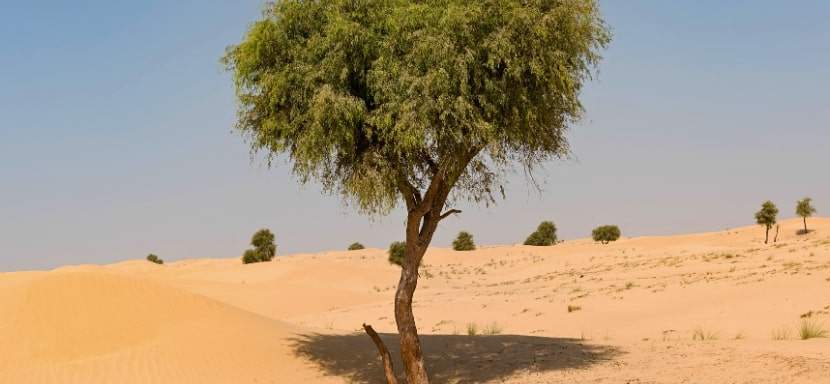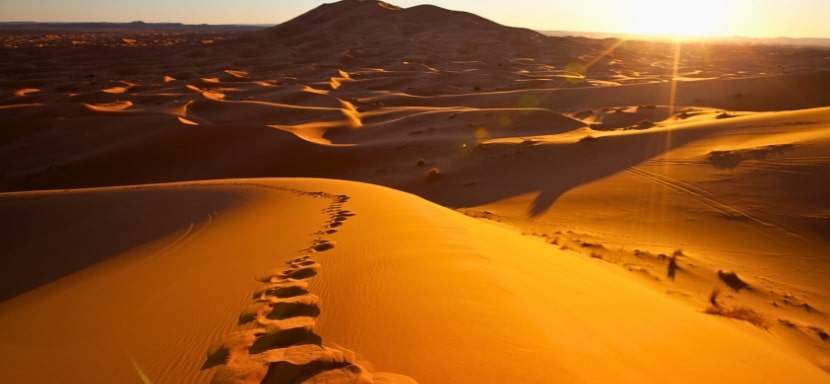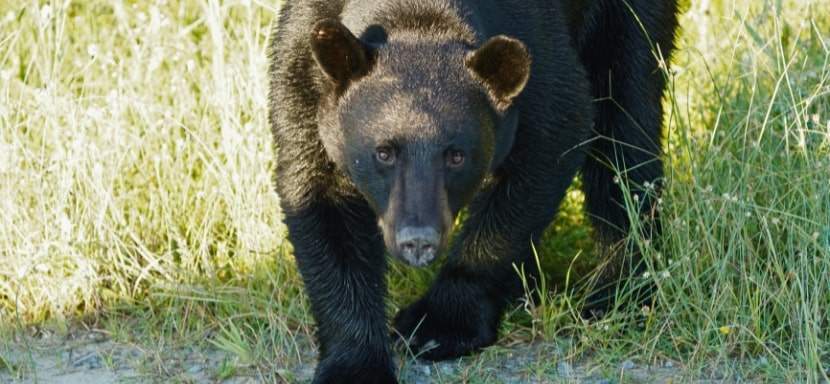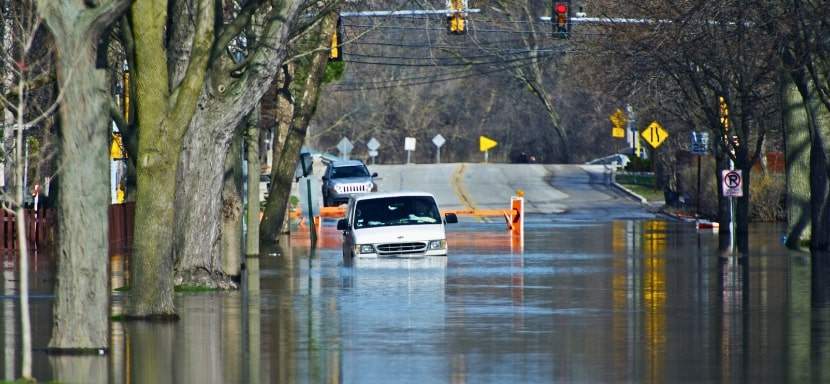How to Survive in the Desert

Desert Survival Tips and Strategies
Dry, hot, and unforgiving, the sandy wasteland poses one of Earth’s most difficult survival challenges.
Your first enemy is the sun. It tricks your mind as it beats down on you all day. Is that a stream on the horizon, or is it just another desert mirage?
One of the most important things to remember during a desert survival situation is that every move you make will deplete the precious water in your system.
What Classifies as a Desert
A desert is a dry, barren area with very little rain, making it difficult for plants and animals to survive. It typically receives less than 250 millimeters (10 inches) of rain annually and can have extreme temperature variations between day and night. Deserts can be hot or cold and are found worldwide.
Introduction to Desert Survival
Embarking on an adventure into the desert’s vast expanse presents a unique blend of allure and danger. The stark beauty of the landscape contrasts sharply with the challenges it poses to survival. Understanding the desert environment and mastering fundamental survival principles are crucial for anyone looking to navigate this harsh terrain safely.
The Allure and Dangers of the Desert:
- The desert captivates with its vast, open spaces, unique ecosystems, and the promise of solitude and reflection. Its undeniable beauty offers spectacular sunsets, starry nights, and landscapes that stretch as far as the eye can see.
- However, this beauty comes with inherent dangers. The desert’s harsh conditions include extreme temperatures, scarce water sources, and potentially dangerous wildlife. These factors create a challenging environment for survival.
Fundamental Survival Principles in Arid Conditions:
- Water is Life: Prioritize finding and conserving water. Dehydration can set in quickly in the desert, so knowing how to source and purify water is paramount.
- Shelter from the Sun: Protect yourself from the intense desert sun to avoid heatstroke and sunburn. Use natural shade or create your shelter to rest during the hottest parts of the day.
- Stay Cool and Warm: Understand the desert’s temperature extremes. Wear light, breathable clothing daily and warm layers by night to manage the significant temperature swings.
- Navigate Wisely: Deserts can be disorienting. Learn to use navigational tools like compasses and maps, and familiarize yourself with the terrain to avoid getting lost.
- Be Prepared: Always let someone know your itinerary before venturing into the desert. Carry essential survival gear, including a first-aid kit, signaling devices, and enough food and water supplies.
Understanding the Desert Environment
Venturing into the desert means stepping into a world unlike any other. Survival depends not only on your skills and gear but also on your understanding of your environment.
To navigate the desert successfully, it’s essential to grasp the nuances of different deserts and debunk some of the myths that might lead you astray.
Types of Deserts and Their Characteristics:
- Hot and Dry Deserts: Think Sahara or Sonoran. These are your quintessential deserts with extreme heat during the day and cold at night. Dunes, scarce water, and minimal shade are typical.
- Semi-Arid Deserts: These deserts, like the sagebrush of Utah, experience slightly more rainfall than their hot and dry counterparts. They feature hardy shrubs and have more moderate temperature fluctuations.
- Coastal Deserts: Found along coastal areas, these deserts (such as the Atacama) receive calm winds from the sea, resulting in mild temperatures but very little rainfall.
- Cold Deserts: Yes, deserts can be chilly! The Gobi Desert is a prime example. These deserts have snow in the winter and short, somewhat warm summers. Water is still scarce, but the main challenge is the cold.
Common Misconceptions About Desert Survival:
- You can always find water in cacti: This is a dangerous myth. Not all cacti provide safe, drinkable water. Some can be toxic, and extracting water from them is often more effort than it’s worth.
- Deserts are always hot: As mentioned, this isn’t true for cold deserts like the Gobi. Temperatures can plummet at night, requiring preparation for cold-weather survival as well.
- You can survive a long time without water: While humans can survive longer without food, going without water, especially in the desert, can lead to severe dehydration in a day or two.
- Animals are the biggest threat in the desert: While it’s wise to be cautious of wildlife, the environment (temperature extremes, sun exposure, dehydration) is often the more significant danger.
Did You Know?
Optical illusions, commonly known as mirages, are created by the refraction of light from the sky by the sun heating the air.
Don’t Get Out of the Car
This survival tip may seem like a no-brainer, but with advances in modern transportation, Many of us travel across desert wastelands without ever considering it.
What happens if you break down in the middle of the desert? The most important thing is to not get out of the car.
Our normal human instinct is to go for help. Leaving the shelter of your vehicle could be a tragic life-or-death decision if you remember seeing a source of shelter like a place of business or residence not too far away from where you broke down.
You will want to leave a note on your vehicle that can easily be seen describing what direction you went. This will help any passerby or emergency personnel know you may need help.
Desert Survival: It’s All in the Prep
Preparation is vital before you step foot into the vast expanse of the desert. It’s not just about having a sense of adventure; it’s about equipping yourself with the knowledge and tools you’ll need to navigate the challenges. Every detail counts, from selecting the right gear to planning your journey meticulously.
Let’s break down the essentials for gearing up and planning your desert adventure.
Essential Gear and Supplies:
- Water and Hydration System: Pack more water than you need. Consider a hydration bladder for easy access and portability. As backups, water purification tablets or portable filters should be included.
- Protective Clothing: Opt for lightweight, breathable fabrics that cover your skin to protect against the sun. Don’t forget a wide-brimmed hat, UV-protection sunglasses, and a high-SPF sunscreen.
- Navigation Tools: A reliable GPS device, a compass, and detailed area maps are non-negotiable. Technology can fail, so knowing how to use traditional navigation tools is crucial.
- First-Aid Kit: Include items for treating minor injuries and ailments. Consider adding sunburn relief, rehydration salts, and any personal medications.
- Shelter: A lightweight tent or emergency bivvy can protect you from the elements. Pack a reflective blanket to combat the cold desert nights or to provide shade during the day.
- Lighting: A headlamp or flashlight (with extra batteries) is essential for night-time navigation or emergency signaling.
- Multi-Tool and Repair Kit: A good multi-tool can be invaluable for gear repairs or unexpected situations.
Planning Your Trip and Informing Others:
- Research the Area: Understand the specific challenges of the desert you’ll visit. Water sources, weather patterns, and potential hazards should all be part of your research.
- Plan Your Route: Determine your entry and exit points, water stops, and camp locations. Considering the challenging terrain and conditions, keep your daily distance goals realistic.
- Inform Others: Always let someone know your plan, including your route, expected return time, and what to do if they don’t hear from you. This is a vital safety measure.
- Check the Weather: Desert conditions can change rapidly. Check the forecast until you depart, and be prepared to adjust your plans accordingly.
- Know Your Limits: Be honest about your physical condition and survival skills. The desert is not the place to overestimate your abilities.

Water Sourcing in the Desert
Water sourcing stands out as the most crucial and challenging element. With its arid embrace, the desert makes water a necessity and a lifeline.
Staying hydrated is paramount. Discover the techniques that could save your life by helping you find and purify water in the desert.
With knowledge and ingenuity, you can turn the daunting task of sourcing water into a manageable one.
The Importance of Water and Hydration:
- Survival Priority: In the desert, water is your top priority. Your body can survive for weeks without food but only days without water, especially in extreme heat, where you lose fluid rapidly through sweat.
- Avoiding Dehydration: Staying hydrated prevents dehydration, leading to disorientation, heatstroke, and, in severe cases, death. The early signs of dehydration include thirst, dry mouth, and fatigue, signaling the urgent need for water intake.
Techniques to Find and Purify Water:
- Seeking Indicators of Water: Look for signs like vegetation, animal tracks, or damp sand that might suggest nearby water sources. Valleys and low-lying areas are potential spots for groundwater.
- Collecting Condensation: Utilize the temperature difference between night and day. Tie a cloth around your legs and walk through dewy grass at dawn. Squeeze the collected water into a container.
- Digging for Water: In dry riverbeds or valleys, dig a deep hole until you hit moist soil. Water may seep into the hole, which can then be purified.
Solar Stills and Dew Collection Methods:
Building a Solar Still: A solar still uses the sun’s heat to evaporate water from the ground or vegetation, condensing on a transparent covering and dripping into a container. To build one, you need a digging tool, a container, a transparent plastic sheet, and a small rock.
- Dig a bowl-shaped hole.
- Place the container in the center.
- Cover the hole with the plastic sheet, securing the edges with soil to prevent moisture escape.
- Place a small rock in the center of the sheet above the container, creating a low point for water to collect and drip into the container.
- Wait for the sun to do its work. The process is slow but effective in collecting drinkable water.
Harnessing Dew: Dew can provide significant water if collected efficiently. Spread absorbent materials like cloth or even your clothes overnight in areas where dew forms. Wring out the accumulated moisture in the morning.
Purification: Once you’ve sourced water, it’s crucial to purify it. Boiling is the most effective method, but solar disinfection (SODIS) using clear bottles under the sun for hours or chemical purification tablets are practical alternatives when fire isn’t an option.
Finding Food in the Desert
While the desert may seem barren initially, it’s brimming with potential food sources.
From edible plants to insects and small animals, the desert can provide for those who know where and what to look for.
Edible Plants and Insects:
- Knowledge is Power: Before anything, knowing what’s edible and what’s not is crucial. Familiarize yourself with desert flora and fauna before your journey. Books, apps, or survival courses can be invaluable resources.
- Prickly Pear Cactus: A desert staple, this plant is edible and a water source. The fruit is sweet and can be eaten directly, while the pads (after removing the spines) can be cooked.
- Agave and Yucca: Both plants have edible parts, including flowers, seeds, and the base of the leaves. The agave’s heart can be roasted and eaten like a sweet potato.
- Insects: Rich in protein, insects like ants, grasshoppers, and some beetles are edible. Ensure they are cooked properly to avoid any potential pathogens.
Hunting and Trapping Small Desert Animals:
- Be Resourceful. Small mammals, reptiles, and birds can be good protein sources. However, hunting requires energy and patience. Simple traps and snares can be effective without expending too much energy.
- Safety First: When considering hunting or trapping, ensure you have the basic knowledge to handle and prepare animals safely. To prevent disease, avoid any animals that show signs of sickness.
- Minimal Impact: Always aim to have a minimal impact on the environment. You only need a Hunt or forage for survival and to preserve the ecosystem.
Expert Tips:
- Use Your Senses: Birds and insects can often lead you to edible plants or water sources.
- Conserve Energy: Focus on gathering and hunting during more excellent parts of the day to avoid dehydration and heat exhaustion.
- Stay Safe: Always prioritize your safety over food. Avoid dangerous animals, and don’t take unnecessary risks for a meal.
Building Shelter in the Desert
Where the sun reigns supreme by day and temperatures plummet at night, finding or building the proper shelter is not just about comfort but survival.
Whether you’re up against scorching heat or chilly nights, your chosen shelter can significantly impact your ability to endure the harsh conditions.
Choosing the Right Location for Shelter:
- Seek Shade: During the day, the priority is to protect yourself from the sun. Look for natural shade under rock overhangs or large boulders.
- Avoid Dry River Beds: While it might seem like a good source of potential water, flash floods can turn these areas into deadly traps.
- Consider the Wind: Find a spot sheltered from prevailing winds to avoid a chilly night and keep sand and dust at bay.
Natural Shelters vs. Constructed Shelters:
- Natural Shelters: Caves or rock overhangs offer immediate protection with minimal effort. They can shield you from the sun and wind and even help retain heat during colder nights. However, ensure the area is safe and stable before settling in.
- Constructed Shelters: If natural shelters aren’t an option, you must build one. A simple lean-to, made from available materials like branches and covered with foliage for insulation, can offer respite from the sun and retain heat after dark. Remember, the goal is to create a small, insulated space where your body heat can quickly warm.
Protecting Yourself from the Elements:
- Insulation: Whether using natural or constructed shelters, insulate yourself from the ground to retain body heat. Sands can be cold at night. Use leaves, grasses, or even your survival gear as a barrier.
- Ventilation: In extreme heat, ensure your shelter is ventilated. A small opening can help circulate air and reduce the temperature inside.
- Compact Size: A smaller shelter is easier to heat and maintain. It also requires less energy and materials to construct, saving valuable resources.
Expert Tips:
- Stay Low: Construct shelters close to the ground to minimize exposure to the elements and retain heat during cold desert nights.
- Reflective Surfaces: Use reflective materials, such as a survival blanket, to reflect the sun’s heat away from your shelter during the day and retain warmth at night.
- Adaptability: Be prepared to adapt your shelter based on changing conditions. What works during the day’s heat may need adjustment as temperatures drop.
Navigating the Desert
Navigating the desert, with its vast and often featureless landscapes, can be daunting.
However, you can navigate this seemingly endless expanse with a few ancient skills and an understanding of the natural world.
Understanding and Using the Sun and Stars for Navigation:
- Sun Position: The sun rises in the east and sets in the west. During the day, you can use this knowledge to maintain a general sense of direction. Remember that the sun’s position shifts slightly throughout the day and varies depending on the season.
- Shadow Stick Method: Place a stick upright on the ground and mark the tip of its shadow with a stone. Wait about 15-30 minutes, and mark the new position of the shadow tip with another stone. The line connecting these two points roughly aligns with east (first mark) and west (second mark).
- Stars: At night, the stars are your guides. Learn to identify Polaris, the North Star in the Northern Hemisphere, which remains fixed in the sky and directly indicates north. The Southern Cross constellation points toward the South Celestial Pole in the Southern Hemisphere.
Landmarks and Natural Navigation Aids:
- Recognizing Landmarks: Certain features stand out in the desert, such as rock formations, mountains, or distinct vegetation patches. Use these as points of reference to maintain your bearings and make mental or physical notes of their location about your direction of travel.
- Watercourses: Dry riverbeds and washes can serve as natural paths. They often lead to lower ground, which may increase your chances of finding water or more visible landmarks.
- Animal Trails: Animals frequently move between water sources and their habitats. Observing and following these trails can lead you to essential resources or out of the desert.
Expert Tips:
- Practice Makes Perfect: Before relying on these methods in a survival situation, practice them during safe, planned outings.
- Use Technology Wisely: While traditional navigation skills are invaluable, complement them with modern Technology, such as GPS devices or compass apps on your smartphone, but don’t rely solely on them.
- Stay Oriented: Check your direction regularly, especially after resting or navigating obstacles. The desert’s uniform terrain makes it easy to veer off course.

Dealing with Extreme Desert Temperatures
Navigating the extremes of desert temperatures is a critical skill for any adventurer or survivor. The desert is a land of contrasts, where the day’s scorching heat swiftly turns to bone-chilling cold as the sun sets. Adapting to these conditions requires preparation, knowledge, and a bit of ingenuity.
Surviving the Scorching Daytime Heat:
- Stay Hydrated: Drink water regularly, even if you’re not thirsty. Dehydration can sneak up on you, impairing your ability to make decisions and physically respond to the environment.
- Wear Appropriate Clothing: Light-colored, loose-fitting, and breathable clothing reflects sunlight and helps facilitate sweat evaporation, keeping you more relaxed.
- Use Sun Protection: A wide-brimmed hat, sunglasses, and sunscreen protect your skin and eyes from UV rays. Don’t underestimate the desert sun.
- Seek Shade: Rest in the shade during the day’s peak heat. This is also an excellent time to plan your next moves or take a nap.
- Limit Exertion: To avoid heat exhaustion, Perform strenuous activities during the more excellent parts of the day, such as early morning or late afternoon.
Staying Warm During Cold Desert Nights:
- Layer Up: The desert can get surprisingly cold as the sun sets. Wear multiple layers of clothing to trap body heat. Don’t forget a hat; body heat is lost through the head.
- Insulate From the Ground: The ground will draw heat from your body. Use a sleeping pad, layers of clothing, or even dry foliage to insulate yourself from the cold earth.
- Use a Windbreak: Construct a barrier or find natural shelter to protect yourself from the wind, which can significantly increase the chill factor.
- Stay Dry: Ensure your clothing and gear are dry before nightfall. Moisture wicks heat away from your body, increasing the risk of hypothermia.
- Huddle for Warmth: If you’re not alone, sharing a tent or huddling together can help conserve heat.
Expert Tips:
- Monitor Your Body: Pay attention to signs of heat exhaustion during the day and hypothermia at night. Early detection can save your life.
- Adapt Your Shelter: If you’ve built a shelter, adjust it for the time of day. It should offer shade and ventilation during the day and insulation and wind protection at night.
- Stay Informed: Knowing the weather forecast can help you prepare for temperature extremes, especially if drastic changes are expected.
Recognizing and Treating Heat-Related Illnesses
The heat of the desert can be as much a foe as the scarcity of water or the rugged landscape. Recognizing and treating heat-related illnesses such as heat exhaustion and heat stroke become crucial skills in these extreme conditions. Equally important is knowing how to prevent these conditions from arising in the first place.
Heat Exhaustion and Heat Stroke: Understanding the Difference
- Heat Exhaustion: This milder form of heat-related illness can occur after exposure to high temperatures, and it’s often accompanied by dehydration. Symptoms include heavy sweating, weakness, cold, pale and clammy skin, fainting, and vomiting.
- Heat Stroke: This is the more severe form of heat illness and is a medical emergency. Symptoms include high body temperature (103°F or higher), hot, red, dry, or moist skin, rapid and intense pulse, and possible unconsciousness.
Preventing Heat-Related Illnesses:
- Stay Hydrated: Drink plenty of water to prevent dehydration, which can lead to heat exhaustion or heat stroke.
- Dress Appropriately: Wear lightweight, light-colored, and loose-fitting clothing to help keep cool.
- Avoid the Hottest Part of the Day: If possible, limit your physical activities to the more excellent parts of the day, such as early morning or late evening.
- Use Sun Protection: A hat, sunglasses, and sunscreen can protect you from the sun’s rays, helping prevent overheating.
First Aid for Heat-Related Illnesses:
For Heat Exhaustion:
- Move the person to a cooler environment, like a shaded area or an air-conditioned room.
- Lay the person down and loosen the clothing.
- Apply cool, wet clothes to as much of the body as possible.
- Offer sips of water if the person is conscious and able to drink.
- Seek medical attention if symptoms worsen or last longer than an hour.
For Heat Stroke:
- Call emergency services immediately — heat stroke is a medical emergency.
- Move the person to a cooler environment.
- Try to reduce the person’s body temperature by wearing cool clothes or bathing.
- Do NOT give fluids.
Desert Wildlife: Hazards and Precautions
Understanding how to avoid nasty creatures and ensure safe encounters with desert wildlife is paramount for your and their safety.
The desert is teeming with life, adapted uniquely to thrive under extreme conditions.
Venomous Creatures and How to Avoid Them:
- Stay Alert: Many venomous desert creatures, such as snakes, scorpions, and spiders, are camouflaged and can be hard to spot. Always watch where you step, sit, or place your hands.
- Use a Light at Night: Many desert animals are nocturnal. A flashlight or headlamp at night can help you spot and avoid them.
- Check Your Gear: Always shake out shoes, clothing, and gear before use, as venomous creatures can hide inside seeking warmth or shelter.
- Avoid Provocation: Many bites and stings occur when an animal is startled or threatened. Give wildlife a wide berth and avoid reaching into crevices or under rocks where you can’t see.
Safe Encounters with Desert Wildlife:
- Observe from a Distance: Enjoy the experience from a distance if you encounter wildlife. This ensures both your safety and the well-being of the animal.
- Do Not Feed the Animals: Feeding wildlife can alter their natural behaviors, make them dependent on humans for food, and increase the likelihood of hostile encounters.
- Stay Calm: If you come across a larger animal, such as a coyote or bobcat, remain calm, appear more prominent, and slowly back away. Do not turn your back or run; this can trigger a chase response.
- Be Cautious at Water Sources: Water sources can attract animals. When approaching, be extra vigilant, as predators may be nearby.
- Educate Yourself: Before heading into the desert, learn about the specific types of wildlife you might encounter and how to identify them.
- First Aid Knowledge: Know basic first aid for bites and stings. While not all will be life-threatening, some may require immediate attention.
Watch the Birds
Keep your eye on the sky. Watch for the direction birds fly; they may lead you to a usable water source.
Survival Techniques: Fire Building and Signaling for Help
Whether you’re stranded or need to keep warm during the cold desert nights, these skills can mean the difference between being found or staying lost and between comfort and hypothermia.
Here’s how to master the art of fire-building and signaling for help, even in the most challenging desert environments.
Techniques for Starting a Fire with Limited Resources:
- Use What You Have: Even in the desert, resources like dry grass, small twigs, and even your items can be used as fuel.
- Magnifying Glass Method: If you have a magnifying glass or any lens that can focus sunlight, use it to direct the sun’s rays onto your tinder pile. This method requires patience and a clear, sunny day.
- Battery and Steel Wool: A battery and fine steel wool can create sparks to ignite fuel. Rub the battery’s terminals against the wool and quickly transfer it to your pile of tinder.
- Friction-Based Methods: Techniques like the hand drill or bow drill use the friction of spinning a wooden spindle against a baseboard to generate heat and, eventually, sparks. These methods require practice and the correct type of wood.
Creating Signals Visible from the Air and Ground:
- Smoke Signals: Once you have a fire going, adding green vegetation can produce smoke that is visible from a distance. Create three distinct fires or smoke signals in a triangle, an internationally recognized distress signal.
- Mirrors or Reflective Objects: Use mirrors, CD pieces, or any reflective surface to catch the sun’s rays. Aim the reflection toward a search plane or rescuer. The flash can be seen from miles away.
- Bright Clothing or Materials: Arrange brightly colored clothing or materials in an open area to spell out an SOS or create a noticeable pattern. Choose a spot that maximizes visibility from the air.
- Rock or Sand Signals: In sparse vegetation, use rocks or drag your foot through the sand to create large SOS letters or arrows pointing to your location. Make sure these signs contrast with the surrounding terrain for better visibility.
Expert Tips:
- Prioritize Your Energy: Assess your situation before you start building a fire or creating signals. Use your energy wisely, focusing on tasks that increase your chances of survival and rescue.
- Practice Before You Need It: These skills can be challenging to master on the spot. Practice fire-starting techniques and creating signals before you find yourself in a survival situation.
- Stay Put if Possible: If you’ve already signaled for help, staying in one place can increase your chances of being found. Moving around can make it harder for rescuers to locate you.
Mental and Physical Preparedness
Mental and physical preparedness is the bedrock of survival, enabling you to withstand psychological pressures and maintain the physical endurance needed in harsh conditions.
Mental Preparedness: Navigating Psychological Challenges
- Stay Positive: Maintaining a positive outlook is crucial. A positive mindset can significantly influence your ability to think clearly and make sound decisions under pressure.
- Set Small Goals: Break down your survival tasks into manageable goals. Achieving these can provide a sense of progress and boost your morale.
- Practice Mindfulness and Stress Management: Techniques such as deep breathing or meditation can help manage stress levels, keeping panic at bay.
- Mental Rehearsal: Visualize yourself successfully overcoming obstacles. This mental rehearsal can enhance your confidence and problem-solving skills in real scenarios.
Physical Preparedness: Building Endurance for Harsh Conditions
- Regular Exercise: Maintain a routine that includes cardiovascular fitness, strength training, and flexibility exercises. A fit body is more resilient to extreme conditions.
- Acclimate to the Environment: If possible, spend time in similar environments to your destination before your trip. Gradual exposure helps your body adjust to extreme temperatures.
- Learn Survival Skills: Being physically fit also means being capable of performing essential survival tasks, such as building a shelter or walking long distances. Practice these skills to build physical confidence.
- Nutrition and Hydration: A well-nourished body copes better with stress and fatigue. Understand the importance of maintaining hydration and managing your energy reserves efficiently.
Case Studies: Real-Life Desert Survival Stories
Real-life desert survival stories are not just narratives of endurance and resilience; they’re treasure troves of lessons and strategies that can illuminate the path for future adventurers. Let’s explore some key takeaways from successful survival stories and highlight common pitfalls to avoid.
These insights can serve as a guiding light, offering practical advice and wisdom gleaned from the experiences of those who have navigated the desert’s harsh realities.
Lessons Learned from Successful Survivals:
- Water is Your Priority: Almost every survival story emphasizes the importance of finding, conserving, and rationing water. Innovative water collection methods have often been lifesavers, such as using condensation traps or extracting moisture from plants.
- Stay Put or Signal for Help: Many survivors were rescued because they stayed in one place, making it easier for rescuers to find them, or they used effective signaling techniques, such as mirrors, fires, or makeshift flags.
- Preparation and Knowledge Pay Off: Those with basic survival knowledge, whether from personal research or survival courses, fared better. Knowing how to build a shelter, signal for help, or navigate can make a significant difference.
- The Will to Survive: Strong willpower and a positive mindset are common threads among survivors. Many credited their survival to the mental strength that kept them pushing forward despite the odds.
Common Mistakes to Avoid:
- Underestimating the Desert: One of the most common mistakes is not respecting the desert’s extreme conditions. Overestimating one’s ability to find food and water or navigate the terrain can lead to dangerous situations.
- Poor Planning: Failing to inform others of your travel plans or not bringing essential survival gear has led to many a survival story. Always let someone know your itinerary and pack appropriately.
- Ignoring Weather Conditions: The desert can be brutally hot by day and freezing at night. Not preparing for these temperature swings by neglecting to bring adequate clothing and shelter materials is often regretted.
- Panic and Rash Decisions: Panic can lead to poor decision-making, such as wandering for help or water. Staying calm and making informed decisions based on survival priorities is crucial.

Equip Basic Desert Survival Gear
The unforgiving desert environment requires you to be well-prepared with tools and supplies that can help ensure your safety, hydration, and ability to navigate and signal for help. Below is a comprehensive desert survival gear checklist curated to equip you for the challenges of arid landscapes.
This list combines the essentials for hydration, shelter, navigation, and emergencies, ensuring you’re ready to face the desert’s tests.
Desert Survival Gear Checklist:
- Water Containers: Multiple, durable water containers are a must for carrying and storing your most critical resource—water.
- Water Purification Supplies: Portable filters, purification tablets, or a solar still kit can ensure your water is safe to drink.
- Sun Protection: A wide-brimmed hat, UV-protective sunglasses, and high SPF sunscreen will protect you from the desert sun’s intense rays.
- Appropriate Clothing: Wear lightweight, long-sleeved, breathable clothing to cover and protect your skin during the day and extra layers for cold nights.
- Footwear: Durable, comfortable boots for walking on hot, rough terrain.
- Navigation Tools: A reliable compass or GPS device and a detailed area map.
- Multi-Tool: A good quality multi-tool can be versatile and practical for repairs, building shelters, and preparing food.
- First-Aid Kit: Include items specifically for desert issues, such as sunburn, blisters, and heat exhaustion, alongside general first aid supplies.
- Fire Starting Kit: Waterproof matches, a lighter, and fire starters can help you build a fire for warmth, cooking, and signaling.
- Emergency Shelter: A lightweight tent, bivy sack, or large emergency blanket can protect you from the elements.
- Flashlight or Headlamp: Plus extra batteries for navigating and signaling in the dark.
- Signal Mirror: A simple tool that can reflect sunlight and signal rescuers from a distance.
- Whistle: This is for signaling help without exhausting your voice.
- High-Energy Snacks: Lightweight and nutrient-dense food items like nuts, jerky, and energy bars.
- Insulation: An insulated jacket and a sleeping bag are rated for the temperature extremes you might face.
- Personal Locator Beacon (PLB) or Satellite Messenger: This is for emergencies where you must alert rescue services at your location.
Expert Tips:
- Pack Smart: Balance between being prepared and overpacking. Every extra pound can make a big difference in your energy expenditure.
- Know Your Gear: Familiarize yourself with how each piece of equipment works before you find yourself in a survival situation.
- Regular Checks: Before you set out, ensure all gear, especially electronics and batteries, is in working condition.
- Customize Your Kit: Consider any personal needs or specific environmental challenges in the desert you’re exploring.
Conclusion: The Essence of Desert Survival
As we wrap up our comprehensive guide to surviving in the desert, we must reevaluate and underscore the pivotal strategies and mindset that can make the difference between merely enduring and genuinely thriving in such a demanding environment. The desert, with its stark beauty and extreme conditions, tests the limits of human resilience and ingenuity.
Recap of Key Survival Strategies:
- Water is Life: Prioritize sourcing, conserving, and rationing water above all else. Innovative methods like dew collection or solar stills can be lifesavers.
- Shelter and Shade: Protect yourself from extreme temperatures by using natural shade or constructing shelters to shield yourself from the sun’s intensity and retain warmth at night.
- Stay Informed and Prepared: Knowledge is power. Understand the specific challenges of the desert you’re entering and equip yourself with the necessary gear and skills.
- Signaling and Navigation: Master non-technological methods for signaling for help and navigating. Reflective mirrors, smoke signals, and celestial navigation can guide you to safety or lead rescuers to you.
- Adapt and Overcome: Flexibility and a problem-solving attitude are crucial. Adapt your strategies to the changing conditions and challenges you face.
The Importance of Respect for the Desert Environment:
- Sustainability and Conservation: The desert is a fragile ecosystem. Practice the Leave No Trace principles to minimize your impact and preserve the environment for future generations.
- Understanding and Preparation: Respect for the desert comes from a sense of its beauty and dangers. Properly preparing for your journey shows respect for the natural elements and ensures a harmonious experience.
- Cultural and Historical Appreciation: Many deserts are rich in cultural history and significance. Recognizing and appreciating these aspects can enrich your experience and foster a more profound respect for the lands you traverse.
Navigating the vast and challenging terrain of the desert requires more than just physical endurance; it demands preparation, knowledge, and a deep respect for the natural environment. From understanding the critical importance of hydration and the art of finding and purifying water to mastering the skills of building shelter, recognizing and treating heat-related illnesses, and signaling for help, every piece of knowledge contributes to your survival toolkit.
Equally crucial is respecting the desert’s beauty and dangers, ensuring we tread lightly and leave no trace. As we conclude our journey through desert survival strategies, remember that the key to thriving in such extreme conditions lies in the skills we’ve discussed and the mindset with which we approach our adventures.
Stay prepared, stay informed, and above all, respect the mighty desert and all it teaches us about survival and ourselves.
FAQs on Desert Survival
How much water should I drink daily in the desert?
Due to the desert’s intense heat and dry conditions, the recommended water intake is significantly higher than the usual 2-3 liters per day. Aim for about 4-5 liters daily, depending on your activity level, temperature, and individual needs. Drinking water regularly is crucial to preventing dehydration, even if you don’t feel thirsty.
What are the first signs of dehydration?
The initial signs of dehydration include thirst, dry mouth, reduced urine output with a darker color than usual, headache, dizziness, and fatigue. Recognizing these early symptoms is vital for immediately rehydrating and preventing more severe dehydration or heat-related illnesses.
Can I eat cactus in a survival situation?
Yes, but with caution. Not all cactus parts are edible, and some can be harmful. The prickly pear cactus (Opuntia) is one of the most widely edible cacti, and both the fruit and pads can be eaten after carefully removing the spines. However, always know which cacti are safe to consume and how to prepare them.
How do I signal for help without technology?
Use visual signals to attract attention. A mirror or any reflective surface can flash sunlight toward a potential rescuer. Creating significant, visible symbols on the ground (such as SOS) in open spaces can also help. Smoke signals from a fire (ensure it’s controlled) are effective, mainly if you can produce thick smoke by adding green vegetation to the fire.
What's the best way to stay cool in the desert heat?
Wear light-colored, loose-fitting clothing to reflect sunlight and allow your body to cool through sweat evaporation. Seek shade during the hottest part of the day, typically between 10 AM and 4 PM. If possible, rest and avoid strenuous activities during these hours. Use a damp cloth on your skin for evaporative cooling, and always wear a wide-brimmed hat and sunglasses.
How can I navigate without a compass or GPS?
Learn basic celestial navigation techniques. The sun rises in the east and sets in the west, which can help orient you during the day. At night, find the North Star (Polaris) in the Northern Hemisphere, which aligns closely with the true North. The Southern Cross points toward the South Celestial Pole in the Southern Hemisphere. Familiarizing yourself with these and other natural landmarks before your trip can aid navigation.
Interesting Desert Facts
Deserts are fascinating ecosystems, defined by their dry conditions and unique characteristics and phenomena. Here’s a list of intriguing facts about deserts:
- Definition of a Desert: Deserts are regions that receive less than 250mm (10 inches) of precipitation per year, making them some of the driest places on Earth.
- Variety of Deserts: Deserts are not all hot and sandy. They can also be cold, like the Gobi Desert in Asia, which experiences snowfall.
- Large Desert Areas: Deserts cover about one-fifth of Earth’s surface, with the Sahara Desert being the largest hot desert, stretching over 9 million square kilometers.
- Desert Temperatures Can Vary Widely: Desert temperatures can vary widely. Daytime temperatures can soar above 38°C (100°F); at night, they can drop sharply, sometimes below freezing.
- Rich Biodiversity: Despite harsh conditions, deserts are home to a diverse range of life adapted to survive with minimal water. Plants like cacti store water in their thick stems, while animals such as camels can go for days without water.
- Rain Shadows Create Deserts: Some deserts are formed by the rain shadow effect, where a mountain range blocks rainfall, creating an area of significantly reduced precipitation on the leeward side.
- Oases Are Real: Oases are deserts where water from underground springs or other sources allows plants and animals to thrive and serve as crucial refuges for life.
- Desertification: This process, in which fertile land becomes desert, typically due to drought, deforestation, or inappropriate agriculture, poses a significant environmental threat, affecting millions worldwide.
- Ancient Civilizations: Many ancient civilizations, including the Egyptians and Mesopotamians, flourished in desert regions, utilizing innovative irrigation techniques to support agriculture and settlements.
- Solar Power Potential: Deserts are ideal for solar energy production with their vast open spaces and high solar irradiance. They offer a renewable energy source that could help address global energy needs.
Historical Desert Survival Stories
Desert survival stories are as old as human civilization, capturing tales of endurance, resilience, and the human spirit’s capacity to overcome extreme conditions.
Here are some historical desert survival stories that stand out for their remarkable tales of survival against the odds:
- The Lost Army of Cambyses (524 BC): According to Herodotus, a Persian army of 50,000 men sent by King Cambyses II vanished in the Egyptian desert during a sandstorm. This story is one of the earliest and most enduring mysteries of desert survival, or lack thereof.
- The Caravan of Abd el-Krim (1925): Abd el-Krim and his followers survived a harrowing escape across the Sahara Desert to avoid capture by French forces. Their journey is a testament to their knowledge of the desert and survival skills.
- The Long Walk (1941): This is the purported journey of Slavomir Rawicz and fellow prisoners who escaped from a Siberian Gulag camp and walked over 4,000 miles to freedom in India, traversing deserts and mountains. While the story’s veracity is debated, it remains a powerful tale of endurance.
- Ralph Alger Bagnold’s Expeditions (1930s): A British explorer and soldier, Bagnold led several expeditions into the Libyan Desert, navigating uncharted sand seas. His contributions to desert navigation and survival techniques are legendary.
- Alain Bombard (1952): Though not a desert story on land, Bombard’s survival story at sea carries the essence of desert survival—endurance in a waterless expanse. He drifted across the Atlantic in a small boat without provisions to prove it was possible to survive with only what the sea could provide.
- Mauro Prosperi (1994): A modern tale of desert survival, Italian policeman and pentathlete Mauro Prosperi got lost during the Marathon des Sables (Marathon of the Sands) in Morocco and survived for nine days alone in the Sahara, drinking his urine and eating bats before finding help.
- Douglas Mawson’s Antarctic Journey (1912-1913): While Antarctica is a polar desert, Douglas Mawson’s survival after losing his team and supplies during an expedition across the Antarctic ice is a harrowing tale of human resilience in one of the Earth’s most unforgiving environments.

More Wild Frontier Scenarios
How to Survive a Mountain Lion Attack
Learn how to survive a mountain lion attack with practical steps to protect yourself and stay safe in. Surviving a…
How to Survive a Raccoon Attack
It’s a quiet evening, the moon is out, and maybe you’re taking out the trash or just enjoying a night…
How to Survive a Wild Boar Attack
Encountering a wild boar is like meeting your ex at a grocery store—unexpected, unnerving, and, in most…
How to Survive a Swarm of Bees
Surviving a bee swarm might sound like a scene out of a movie, but it’s a real concern for those who…
How to Survive a Skunk Spray
Getting sprayed by a skunk is a smelly situation that no one wants to find themselves in. However, if…
Recent Survival Posts
How to Survive a Layoff
Layoffs feel personal—even when they’re not. One day, you’re responding to Slack messages and forwarding…
How to Survive a Drug Test
I never imagined I’d be so emotionally invested in a paper cup. But there I was, standing under the fluorescent…
How to Survive an Interrogation
If you’ve ever been caught in the crosshairs of an overly enthusiastic mall cop or stared down by someone…
How to Survive a Nightclub Shooting
Nightclubs pulse with life—lights flashing, music pounding, bodies packed tight on the dance floor. It’s a place to…
How to Survive a Bachelor Party
A bachelor party is a delicate mix of celebration, chaos, and questionable decision-making, wrapped…
More Air, Wild Frontier Survival Scenarios

How to Survive a Raccoon Attack
It’s a quiet evening, the moon is out, and maybe you're taking out the trash or enjoying a night on your porch. And suddenly, out of the shadows, bam! There it is—those black-ringed eyes glowing at you like some creature from a raccoon version of “The Shining.” If...

How to Survive a Wild Boar Attack
Encountering a wild boar is like meeting your ex at a grocery store—unexpected, unnerving, and, in most cases, best avoided. Yet, wild boars aren't interested in your baggage or drama; they're just trying to mind their own business—unless they think you're a threat....

How to Survive a Swarm of Bees
Surviving a bee swarm might sound like a scene out of a movie, but it's a genuine concern for those who love the outdoors. Imagine this: you're hiking on a beautiful sunny day, enjoying the tranquility of nature, when suddenly you hear a low buzzing sound that...

How to Survive a Skunk Spray
Getting sprayed by a skunk is a smelly situation that no one wants to find themselves in. However, if you do end up as a target of this defensive mechanism, knowing how to handle the aftermath can make a huge difference. Let's explore some practical steps and advice...

How to Survive a Bear Attack
Bear Attack Survival Tips and Strategies Though rare, bear attacks can occur because bears remember food locations for years and may silently track humans to assess threats or follow scents. Surviving a bear attack involves more than just reacting during an encounter;...
More Survival Scenarios

How to Survive a Layoff
When the Floor Falls Out: The Reality of a Layoff Layoffs feel personal—even when they're not. One day, you're responding to Slack messages and forwarding emails. Next, you're staring at your monitor as it logs you out... for good. Whether it's a restructuring, a...

How to Survive a Drug Test
The Cup, The Room, The Truth I never imagined I’d be so emotionally invested in a paper cup. But there I was, standing under the fluorescent hum of a strip-mall clinic, trying to recall the last time I ate a poppy seed bagel. That’s the thing about drug tests—they...

How to Survive an Interrogation
If you've ever been caught in the crosshairs of an overly enthusiastic mall cop or stared down by someone in a uniform with a clipboard and a glare, you’ve felt it — the chilly fingers of interrogation anxiety. And while most of us imagine interrogation scenes as...

How to Survive a Nightclub Shooting
Nightclubs pulse with life—lights flashing, music pounding, bodies packed tight on the dance floor. It’s a place to escape, feel the rhythm, and lose yourself in the crowd. But that same energy can turn deadly in seconds, transforming a night of fun into one of the...

How to Survive a Bachelor Party
A bachelor party is a delicate mix of celebration, chaos, and questionable decision-making, wrapped in the noble intention of sending the groom off into married life with a night he’ll (hopefully) remember. It’s a ritual as old as time—well, as old as men deciding...

How to Survive Your First Time at the Gym
Walking into a gym for the first time can feel like stepping into an alien world. The machines hum with purpose, the regulars move confidently, and you’re left standing there, clutching your water bottle, wondering whether you’re in the right place—or on the right...

How to Survive a Worldwide Communications Breakdown
Imagine waking up to silence. Your phone doesn’t buzz, your email won’t load, and even your local radio station crackles with static. A worldwide communications breakdown has hit. What next? For many, this doomsday scenario may sound like the opening lines of a...

How to Survive a Flash Flood While Driving
Surviving a flash flood while driving requires quick thinking, calmness, and a solid plan to ensure your safety. Preparation can make all the difference between a close call and a catastrophe in emergencies like this. This guide provides practical advice to protect...

How to Build an Emergency Kit
Emergencies don’t knock politely at the door. They barge in, uninvited, like a distant relative with a penchant for drama, turning your world upside down without warning. Whether it’s a power outage, a natural disaster, or an unexpected evacuation, the key to staying...

How to Protect Yourself From Insects in the Wild
There’s nothing like being out in the wild—birdsong echoing through the trees, the fresh scent of earth, and a deep sense of peace that makes you think, “Ah, this is what life is about.” But then comes the buzzing. Mosquitoes, ticks, and flies swoop in like uninvited...
